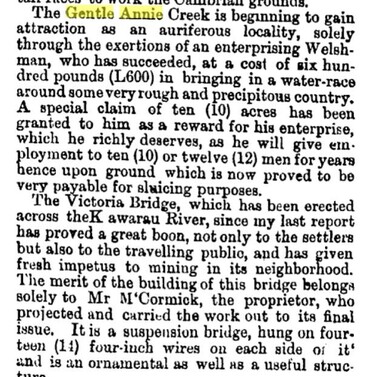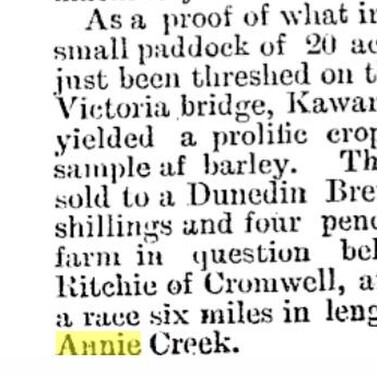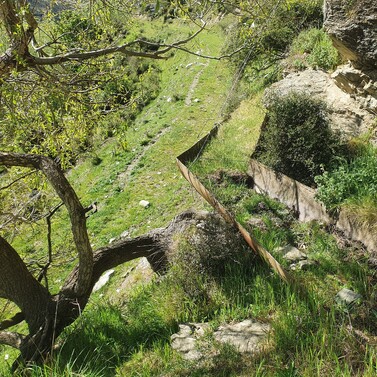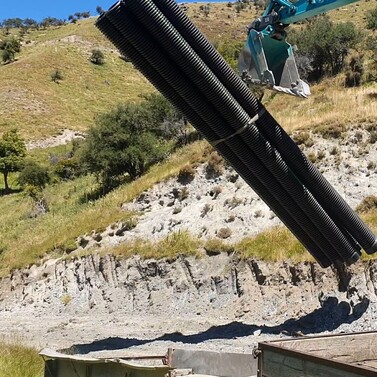History of the Waitiri water race
We’re often asked, where does your water come from? Being far away from town supply, our water is completely off grid. It’s fed from the western branch of the Gentle Annie creek, known as the Springburn, hence the name of our nursery! The Springburn is a perennial water source that at our take point drains about 10 square kilometres of high country, Waitiri Station. From there it joins the main branch of the Gentle Annie/Waireika, to the Kawarau, to the Clutha/Mata-Au at the junction (Cromwell), and from there to the sea.
Now, the Springburn is many kilometres away from our nursery. Long term residents of central Otago will be familiar with water races, an old fashioned term for channels used to move water. You can see the scars of old water races cris-crossing all over central Otago, just about everywhere the old gold diggers worked. Many of the diggers that flocked here in the first gold rush of the 1860s were veterans of the California rush, where water races were developed for gold sluicing. They transplanted this technology to Otago, and mastered it.
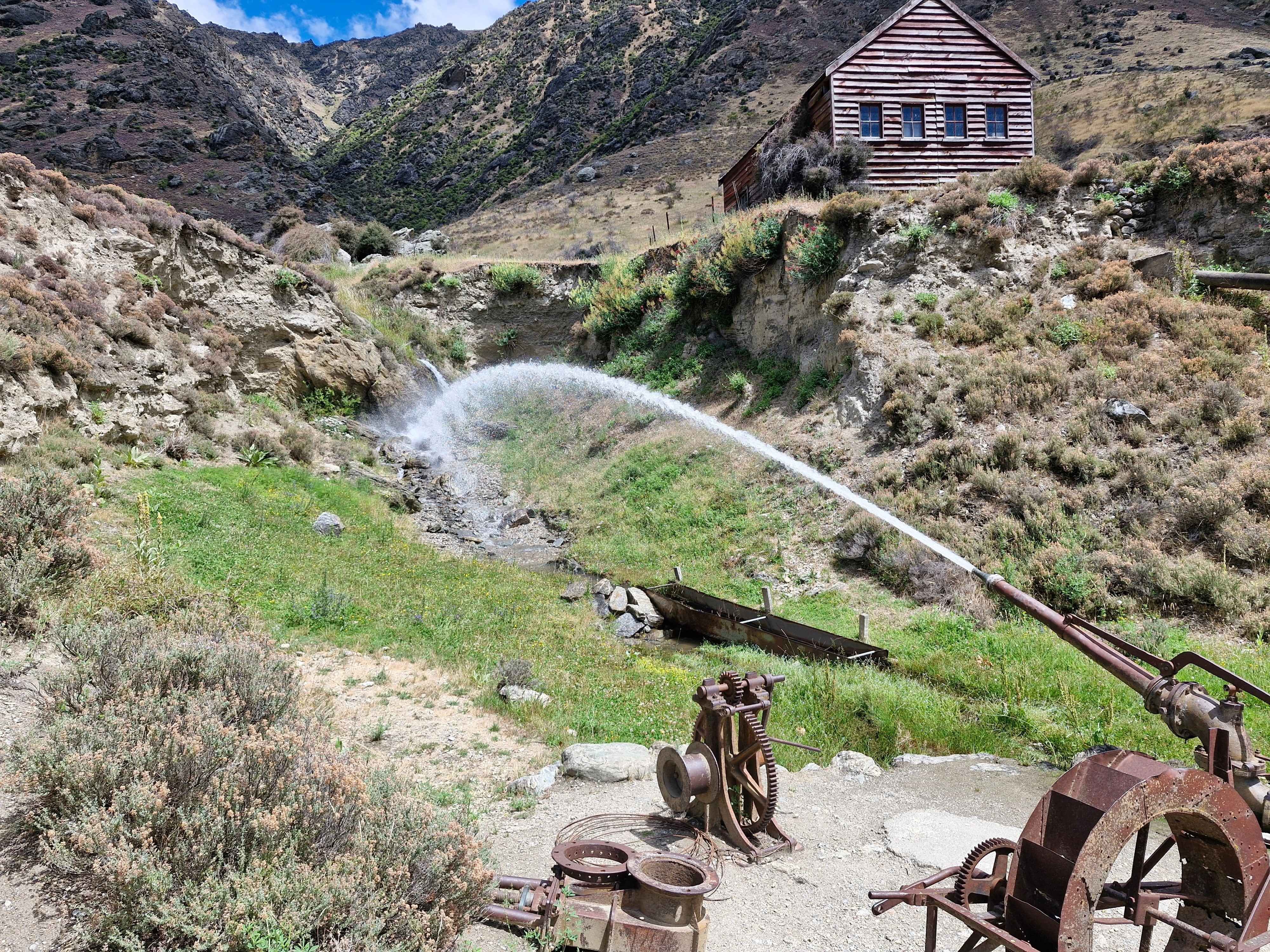
Above: At the end of a head race, diggers could turn the water to water based gold extraction, eg sluicing. This is an original sluice monitor, still in operation, at Goldfields Mining Centre, further down the gorge.
Below: A typical spring view up the Springburn valley, taken from standing on the water race, which is visible as the plateau on the top left, and the natural water course and site of historic digging bottom right. Wild thyme in flower in fore view, all of which is descended from the plants brought by the old diggers to flavour their meals.
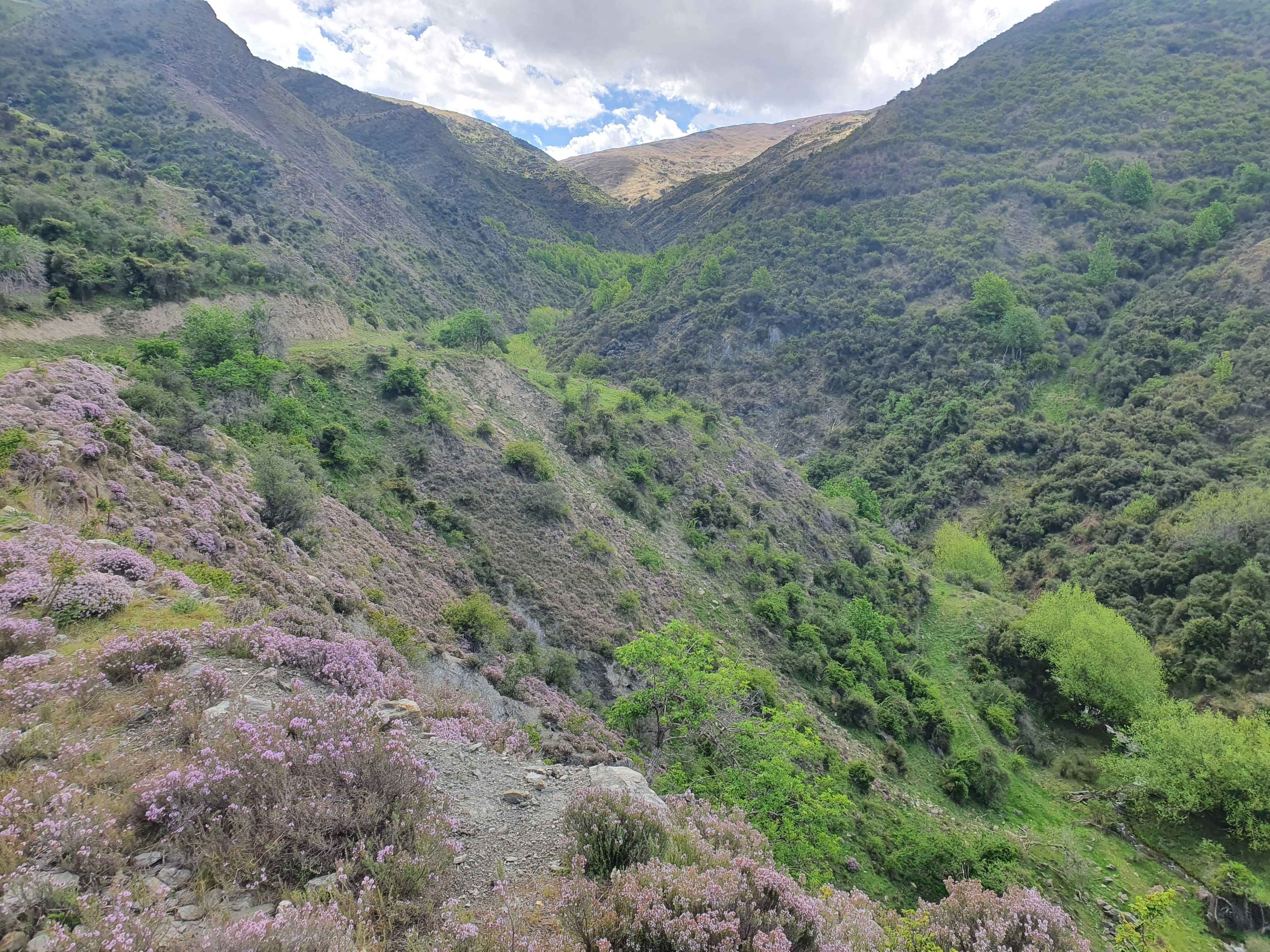
Our water race brings the water from the Springburn to the head of the Waitiri peninsula, snaking around the hills for over 7km. It’s over 150 years old, and has had many sets of hands working on it over the generations, ours included.
The water race at Waitiri was built by one William Meanock in 1871. Meanock is first mentioned in the Victoria Government Gazette as having unclaimed ship letters in Kyneton, Victoria in July of 1861. That is inland so likely he wasn't just stopping over in Melbourne on his way to NZ - more likely he had been working the gold fields in Victoria, perhaps coming there from Britain sometime after the beginning of the Victorian gold rush in 1851.
He is then mentioned in the Otago Witness January 1864, as having donated 10 shillings to the Dunstan Hospital. So he would have come to Otago with gold fever sometime between 1861-1863. He is again mentioned in the Dunstan Times advertisement page in 1866 as selling a "dwelling house of timber and canvas" in the Kawarau Gorge, where he must have been gold digging.
He then began to appear in the Lake Wakatip Mail, Arrow Observer et al from April 1872 as he became involved in a series of legal disputes around his water race. The water race is described as beginning in the "left hand branch of the Gentle Annie Creek" (known today as the Springburn, or Spring Burn) and taking water "a distance of some six or seven miles away" (perhaps a slight exaggeration). He began the race in March 1871. He was the leader of a team of 6 or so miners and his second in charge was called Munro.
Above: Excerpts drawn from Papers Past, a great resource for historical research, where you can do a powerful search of “digitised full-text New Zealand and Pacific newspapers, magazines and journals”
Because he was familiar enough with the land to establish this water race and had a dwelling in the gorge prior to 1866, we suspect he most likely would have been involved in the rush on the Gentle Annie in 1863, or else arrived there between 1863-1866 during which time it was worked continuously.
Meanock is then mentioned again, though not by name, in 1875 in the Evening Star as an "enterprising Welshman" who received a special gold claim of 10 acres for bringing the race around "some very rough and precipitous country". It doesn't specify the location of the claim though one assumes it would have included the area where the sluice tailings are found on the peninsula today.
This claim was well deserved when you consider this race was dug all by hand. The cost of the race is mentioned as being £600 in one article and £1000 in another. Some quick research shows the average daily wage of a labourer in the Otago gold fields at the time was in the region of 9 shilling 6 pence, or about £0.5. So the amount of labour involved was considerable, and all other materials were bought by ox cart from the coast. Even basic building materials we take for granted today, like timber and nails, were expensive and in short supply.
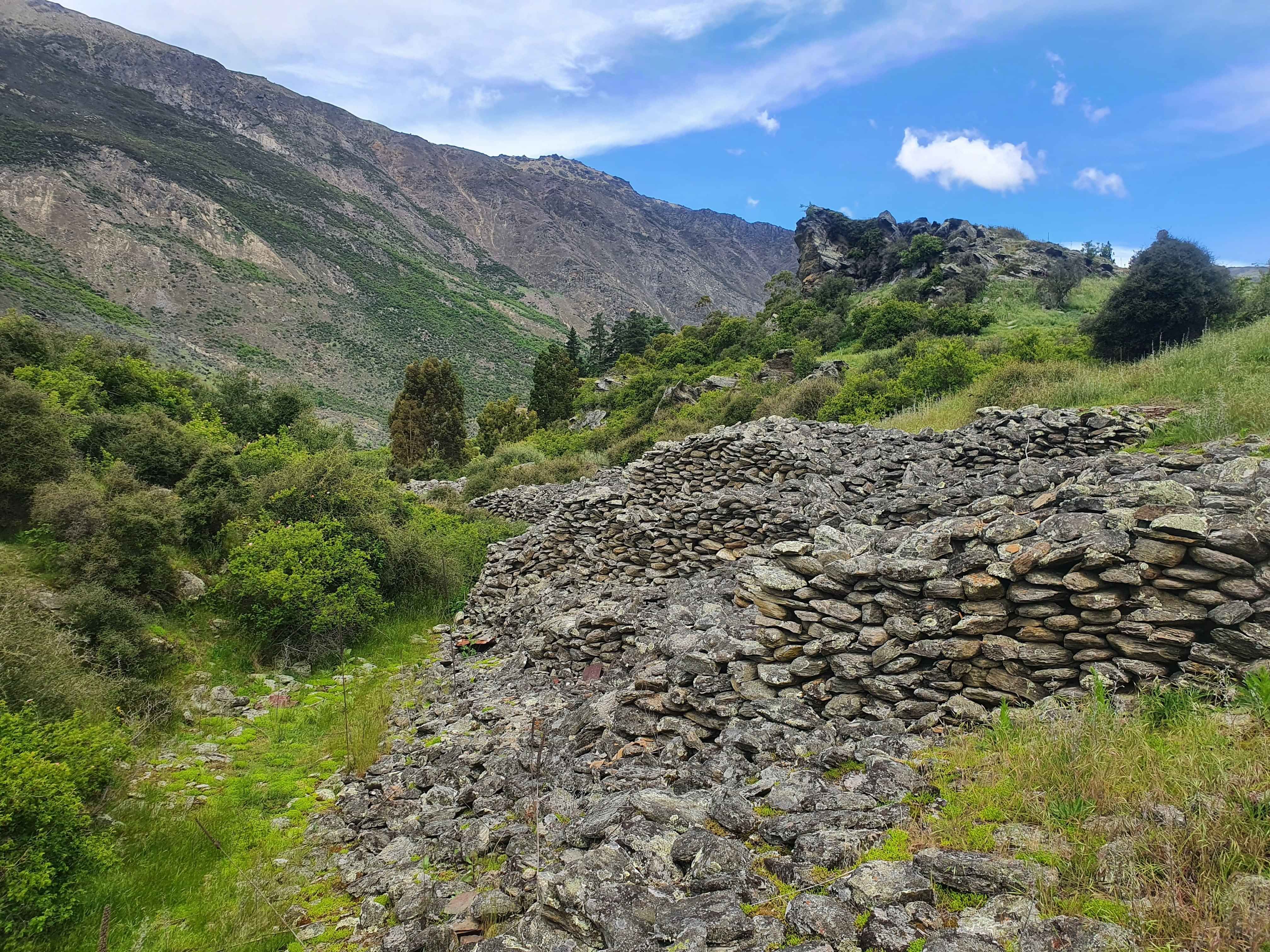
Above: An example of sluice tailings on the Waitiri peninsula today. This huge pile of rocks, taken from the sluice channel on the left, were possibly worked by Meanock himself, but either way date to 100-150 years old and provide a nice lizard habitat nowadays.
It seems the digging in the Gentle Annie died down in the late 1870s/1880s (hard to say when the Chinese left as their actions are not recorded in any detail), but not before the diggers had worked both sides of the Kawarau, from the upper terraces down to the riverbanks, using flying foxes and flumes to move themselves and water across the big river. The new Kawarau Gorge Cycle Trail, hotly anticipated and which we are proud to be supplying plants for, will open public viewing access to the old herring bone sluice tailings on the flat across the Kawarau from the Gentle Annie. There are old stone huts in the scrub there that haven’t been touched since they were abandoned in the 1860s or 70s.
Gold working in the area only restarted in the late 1890s as dredge fever swept central Otago. One can hardly overstate the determination these guys had for dredging. On the short section of the Kawarau river from north of the Victoria bridge around to the Roaring Meg there were 6 dredging operations, each of them assembled on site for what would be the equivalent today of several hundreds of thousands if not over a million dollars.
Despite the astounding amount of gold they took out of the river (100+ ounces a week per dredge in some cases, which is $750000 at today’s price), most of these dredges seem to have struggled financially because the startup and operation costs were so high - coal, animals for towing, men.
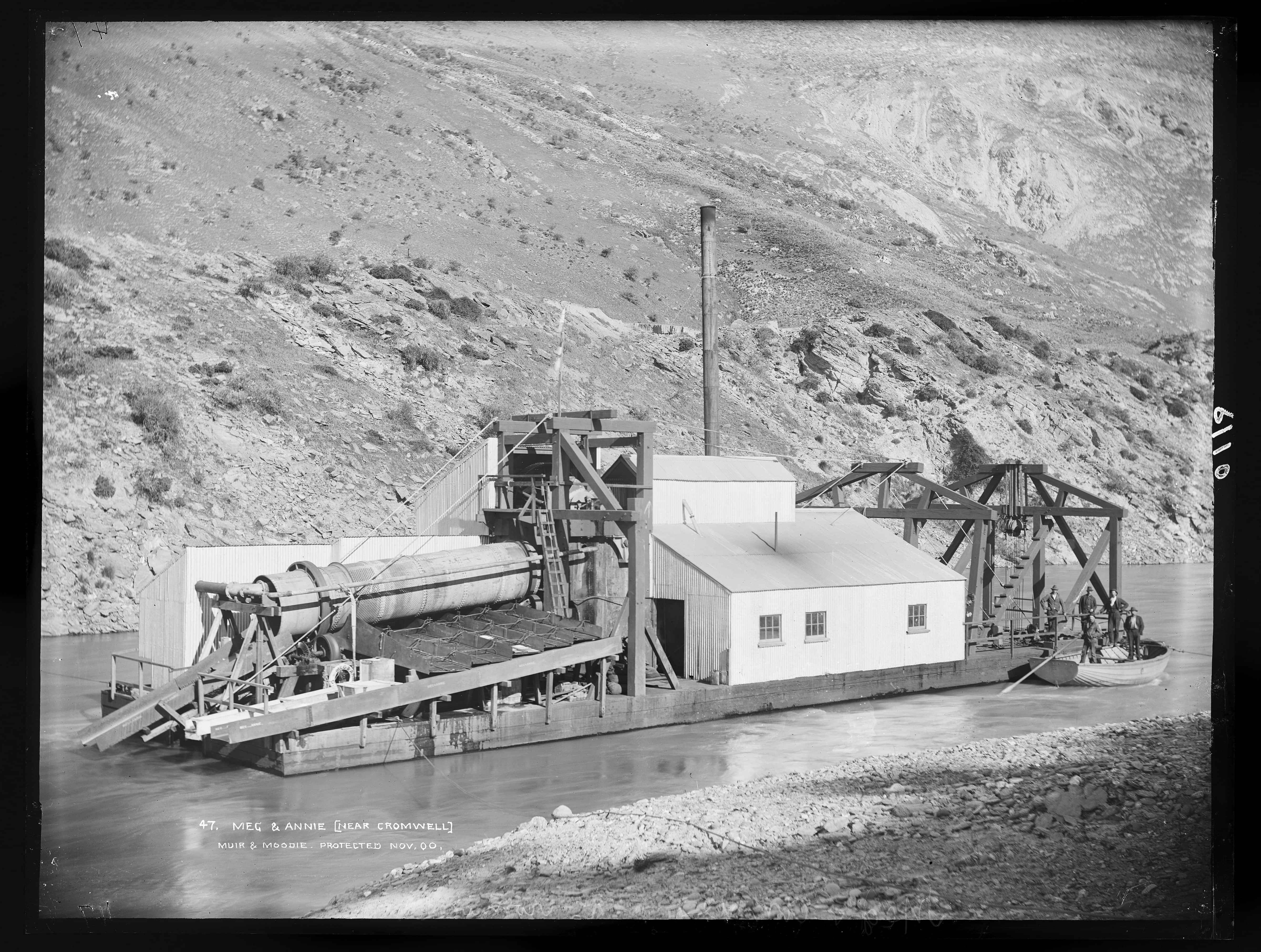
Above: The Meg & Annie dredge, pictured Nov 1900, operating further downriver near Cromwell. Note the absence of willow trees or other vegetation. Courtesy of the Hocken collection
The water race is next mentioned in 1908 as being used by John Ritchie to grow 20 acres of barley on the Waitiri peninsula. John Ritchie was the dredgemaster on the Upper Magnetic claim, (next one down from the Gentle Annie claim) and we assume he became familiar with the area during his time running the dredge, when he would have been living full time somewhere on the banks of the river. He applied for an occupancy lease on the peninsula in 1904 by which time the dredging mania had mostly died down, though the Waitiri Dredging company formed in 1905 to re-dredge all the old claims along this stretch of river for another year or so.
We can only assume it was Ritchie that restored and maintained Meanock's race sometime between 1904 and 1908 and he was the first to use it for farming.
It seems by 1915 Ritchie was farming all the sections that made up the Waitiri peninsula and had established a threshing mill, so he must have had a good amount of land under irrigation growing grain. He sold his farm in 1918 to James McDonald and Malcom Campbell.
Above: Old historic sections of the water race, showing various flumed and pipe sections used to traverse difficult terrain. Nowadays, these are replaced with polyethylene pipes to form a pressurised reverse siphon, but this was not possible for the old timers.
The Sanders brothers, George and Ernie, bought the peninsula farm, now consolidated to some 200 hectares, in 1921, and farmed it continuously for the next 35 years. By the 1930s they had over 1000 sheep, so we presume they had moved away from growing grain as their predecessor Ritchie had and moved the peninsula more into pasture and feed crops. To what extent they used the water race we don’t know.
In 1956 ER and HJ Cook bought the farm and added it to Waitiri station. Generations of the Cook family lived at the Waitiri homestead and this author (Kelvin) has heard that it was John Cook’s job to walk the water race and keep it from washing out. There are many overgrown slips on the hill faces under the water race that were probably caused during this period, the stony terrain being poorly suited for carrying water perpetually. The Cooks upgraded and maintained the race until the 2000s when Tim Edney bought Waitiri station including the peninsula. In the 2010s, he began the major project of incrementally piping the entire water race and this was completed by early 2020.
Above: The job of upgrading all 7km+ of the race from open to piped was a huge one. Much of the earthworks were done by the legendary digger driver, the late Colin Ashmore, in the operating seat of the machine above.
Nowadays, with the race piped, and various concrete intake and diversion structures all built, the race runs clean and reliably year round and provides water to the Waitiri farm, various houses, and of course Springburn Nursery.
